| Fairway History |
* Black Cab History |
 |
 |
 |
 |
 |
 |
 |
|---|
Beardmore
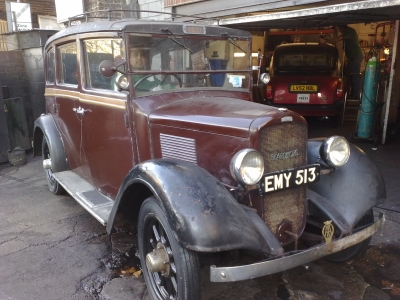
1935 Beardmore

1957 Beardmore

1960 Beardmore, front view
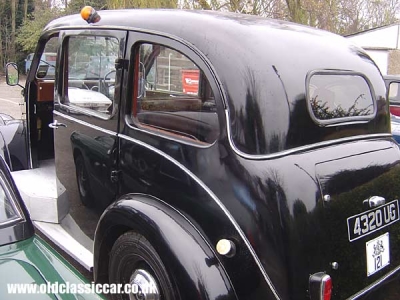
1960 Beardmore, rear view
Production of the Beardmore Taxi began at Paisley in 1919 with what became known retrospectively as the Mk1. This was designed to meet the Metropolitan Police Conditions of Fitness for London Taxis. It was a very tough and reliable vehicle and it earned itself the name of 'The Rolls-Royce of taxicabs'. A car version, the Country and Colonial model was also made, as was a light van. It was replaced in 1923 by the Mk2, which had an all-new chassis, which it shared with a new range of light trucks and buses. Following a change in the Conditions of Fitness, Beardmore introduced a new model, the Mk3 'Hyper'. This had a smaller, 2-litre side-valve engine and was lighter and more economical to run.
Following the removal of William Beardmore from the board of his company in 1929, Beardmore Motors was bought out by its directors, and taxi production was moved from Scotland to Hendon, North London. Here in 1932 a new model, the Mk4 Paramount was introduced, which was essentially an updated Mk3 with a 2-litre Commer engine and gearbox. In 1935, the Mk5 Paramount Ace, with a new longer wheelbase chassis was introduced, with the same engine. It was followed in 1938 by the Mk6 Ace, which had detail refinements. The 1930s Beardmore became known as the 'greengrocer's barrow', because 'all the best things were in front'!
After the Second World War, Beardmore Motors sold and serviced the new Nuffield Oxford cab, until the newly formed British Motor Corporation axed it in favor of their own Austin FX3. Beardmore Motors then returned to making their own cabs. The model they introduced, in 1954 was the Mk7 Paramount, which had a traditional style coach-built body, of aluminum panels over an ash frame, built by Windover. The engine was from a Mk1 Ford Consul, (later, a Mk2 Consul and finally a Ford Zephyr 4) but a Perkins 4.99 diesel was offered from 1956. In the same year, body production was taken over by Weymann at Addlestone. Production of the entire cab was soon moved there. In 1966, when Metropolitan-Cammell bought Weymann, taxi production was moved to MCW's factory at Washwood Heath, Birmingham, where it ended in late 1966. Final production of the Mk7 amounted to just over 650 cabs.
Austin FX 3
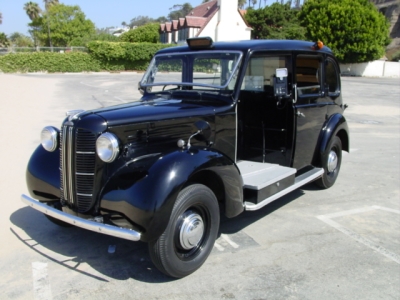
1949 Austin FX3
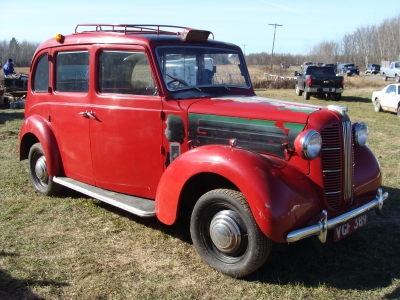
1958 Austin FX3
The Austin FX3 was introduced in 1948, built by Carbodies in Coventry and financed and owned jointly by Carbodies, Austin and Mann and Overton.
The FX3 first appeared with a 2.2 litre petrol engine but had the option of a Ferguson diesel in 1952, before Austin developed its own 2.2 litre diesel in 1954 and an all-steel body from Carbodies. It was available until the late fifties. The first prototype FX3, JXN 841 went on test alongside the FX2, JXN 842. After-market Perkins and Standard diesel engine conversions prompted Austin to develop their own diesel engine which appeared in 1956 and a series of automatic test vehicles in 1957-58, of which two are known to survive.
7267 examplaries of the FX3 were built from 1948 to 1958. The FX3 is also the first London cab to have been exported in numbers all over the world.
Austin FX4, Carbodies/LTI FX4, FX4D, FX4R, FX4S, FX4S+
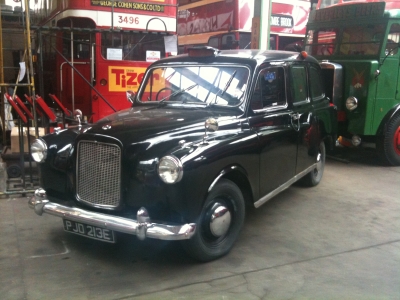
Austin FX4, Museum of Transport, Manchester

Austin FX4 with bunny ears and small tail lights
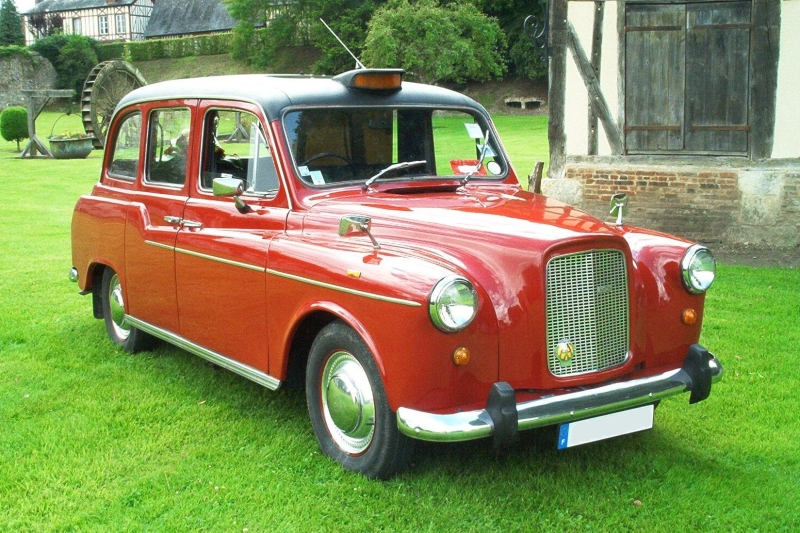
FX4D

FX4S
The FX4 is the classic Black Cab. While the majority are black, there is in fact no requirement for them, or indeed any other make of London taxi to be black. Over the years, the FX4 has been sold under a number of different makers' names. More than 75,000 FX4s had been built.
Design and launch
The FX4 London taxi was the successor to the Austin FX3, which was produced between 1948 and 1958. In its day the FX3 was the most widely used taxi in London. Like the FX3, the FX4 was designed by Austin in collaboration with Mann & Overton, the London taxi dealership that commissioned it (and paid for half of its cost) and Carbodies, the coachbuilder that built the body and assembled the cab ready for sale. The design team included Albert Moore from Austin's engineering division, Jack Hellberg from Carbodies and David Southwell of Mann & Overton. The original design was by Austin's Eric Bailey and it was engineered for production by Carbodies' Jake Donaldson. It would be the first London taxi to go into production that had four doors, since earlier London taxis had featured a luggage platform, open to the elements, on the pavement/sidewalk side at the front of the cabin, beside driver's compartment.
Like the FX3, the FX4 had a separate chassis, but with independent front suspension and dual-circuit hydraulic brakes. The first FX4, registration number VLW 431, was delivered in July 1958 and went on test with York Way Motors. The official launch was later that year at the Commercial Motor Exhibition.
The Austin models
The first model of FX4 was fitted with a 2178cc Austin diesel engine and a Borg-Warner automatic transmission. In 1961, the manual transmission from the Austin Gipsy was available as an option. From 1962, the Austin 2199cc petrol engine was available. However, almost all FX4 taxis were fitted with a diesel engine and, until the mid-1970s most had a manual transmission.
In 1969, the cab was altered, to offer a new version in place of the abandoned replacement model and to amend some of the shortcomings of the original. The original Austins were provided with small rear stop and taillights and roof-mounted turn indicators, commonly known as "bunny ears". On the revised model, the rear wings were modified to accept the taillights and turn indicators from the MkII Austin 1100/1300. Front indicators were also provided below the headlights and repeater indicators fitted to the front wings. The "bunny ears" were abandoned. The interior was also changed, with black vinyl seats and an altered partition to give the driver more legroom.
In 1971, the 2178cc diesel engine was replaced by a larger, 2520cc version. This engine proved to be better for use with an automatic transmission and gradually fewer cabs with manual gearboxes were sold. The petrol engine was discontinued in 1973.
In 1973, Carbodies' owner BSA, by now confronting imminent bankruptcy, was bought by Manganese Bronze Holdings, who were happy to continue making the FX4. Detail changes, such as burst-proof door locks and push-button door handles, safety steering and moulded rubber overriders (designed because the original tooling for the chrome overriders had worn out) were implemented.
The Carbodies FX4
In 1982, Carbodies, who had been producing the FX4 for Austin and Mann & Overton, took over the cab's intellectual property rights when BL, Austin's parent company lost interest in it and began to produce it under their own name. The old Austin engine was no longer available because, during Michael Edwardes' reconstruction of British Leyland, the plant had been sold to India. Carbodies selected the Land Rover 2286cc diesel engine in its place and also offered the similar-sized Land Rover petrol engine as an option. The new model was branded the FX4R, with R standing for Rover. The FX4R had some improvements over the previous FX4 models, including power steering and full servo brakes, but its performance and reliability were poor and the cab gained a bad reputation.
Some proprietors replaced the Land Rover engine with the Perkins/Mazda 2977 cc diesel, which improved the performance of the cab dramatically. Whilst powerful and reliable, the Perkins conversion gained a reputation for being noisy at idle and, mistakenly for causing cracks in the chassis. The chassis problem, which was also occurring on late model Austins was traced to a manufacturing fault.
In order to regain lost sales due to the FX4R's failure, Carbodies took old chassis and suspension and refurbished them, fitting new bodywork and the original-type 2520cc diesel engines re-imported from India. Because these vehicles used refurbished chassis and suspension components, they were required to have a registration mark starting with the letter Q rather than the current year letter and thus this model was known as the FX4Q. All were fitted with automatic gearboxes, but not the power steering fitted to the FX4R. Sold by the dealer Rebuilt Cabs Ltd, they were marginally cheaper than the FX4R.
The LTI FX4
In 1984 London Taxis International (LTI) was formed after Manganese Bronze Holdings bought the London taxi dealers Mann & Overton. LTI replaced the 2286cc Land Rover diesel engine with the new 2495cc version. The new model was called the FX4S. New rocker switches replaced the old toggle switches on the dashboard, the wipers were controlled by a stalk on the steering column and draught proofing was added to the bottoms of the doors and black rolled steel bumpers fitted, but basically it was an updated version of the cab that had been around for almost 30 years. At this time, Carbodies were developing a replacement for the FX4, the CR6, which is why this 'stopgap' FX4S was introduced. However, the CR6 was abandoned in 1985 and MBH decided to carry on making the FX4 until such time as it could fund a new cab. The FX4S was superseded in 1987 by the FX4S-Plus, which had a rear compartment redesigned to allow five passengers, the trim changed to grey. A new grey plastic moulded dashboard was also fitted. This was received very well by the trade, as a sign that their needs were actually being listened to.
The Department of Transport was keen to see wheelchair accessible taxis and the FX4W wheelchair conversion, which was available from early 1986, enabled the FX4 to provide that facility. In this, the curb side passenger door was made capable of opening 180° and the nearside part of the partition could be moved forward to accommodate the rearward facing wheelchair in place of the nearside tip-up seat.
Between 2011 and 2012 the It's on the Meter expedition drove a heavily modified FX4 43,319.5 miles (69,716.12km) around the world, through more than fifty countries, and set new world records for the longest journey ever by taxi and the highest altitude ever reached by taxi.
Carbodies/LTI Fairway and Fairway Driver (1989-1997)
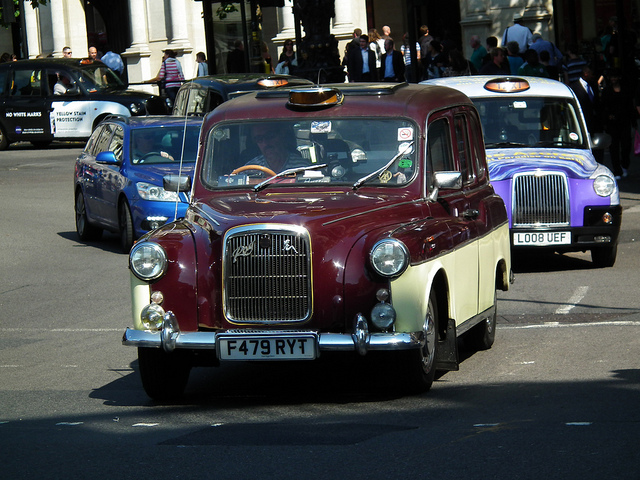
Beautiful 1989 Fairway, with lots of extra chrome trim
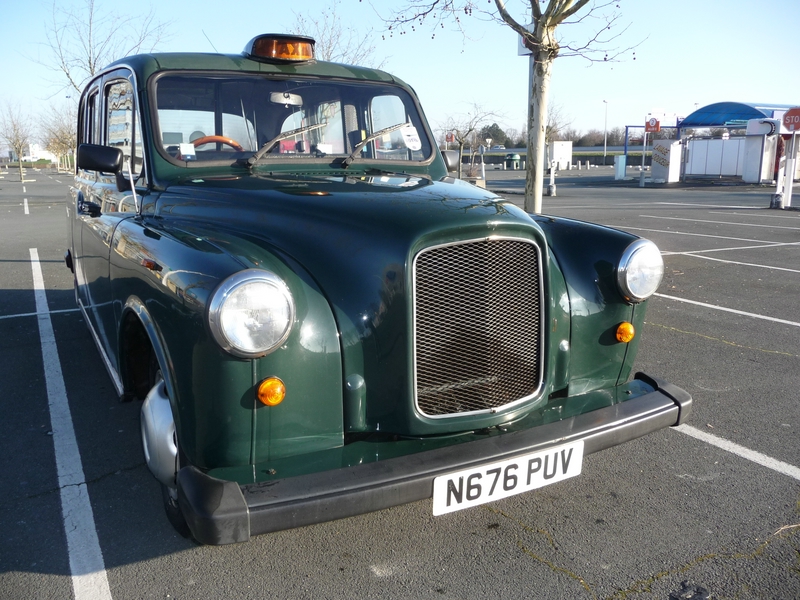
1996 Fairway Driver
In February 1989 the Fairway was introduced. It was fitted with a 2,664 cc Nissan TD27 diesel engine. This made the FX4 a faster and more reliable cab. It had full wheelchair accessibility, in line with a new law that came into force in January 1989. The Fairway was the best version of the FX4 ever built,[peacock term] and enabled LTI to sell to overseas markets, as well as move into provincial UK markets they had not been able to tackle. Much of this increase in sales was due to local authorities insisting on wheelchair accessible cabs being used in their areas.
As part of a programme to develop a replacement model, AP Lockheed were commissioned to design and develop front disc brakes, and in conjunction, GKN designed a new suspension system to allow disc brakes to be fitted whilst maintaining the mandatory 7.6m turning circle. These modifications were fitted to a new model, the Fairway Driver, which was introduced in February 1992. The very final Fairway made, with registration mark R1 PFX (i.e. RIP FX), was built on 1 October 1997 and was presented to the National Motor Museum at Beaulieu.
Transport for London, (TfL) who had taken over control of the Public Carriage Office ruled that by 2006 all taxis licensed in London should comply with Euro 3 exhaust emission regulations. The Fairway, and for that matter its replacement, the TX1, which used the same Nissan engine only complied with Euro 2, but most proprietors were reluctant to get rid of their very reliable and economical Fairways. In the face of pressure from the trade, TfL allowed different conversions systems to be developed that could be fitted to the Nissan engine to make it comply. These were the STT Emtec Clean Cab turbocharger system and the Van Aaken exhaust gas recirculation system. Only 80 Austin- and Rover-engined cabs remained on the road, which made it uneconomical to develop conversions for them so they were granted an exemption. Although some owners of older Fairways got rid of them, many owners opted to spend almost £2000 having their cabs converted, rather than buy a new or second-hand TXII, which was considered to be very unreliable. In late 2009, only six of the earlier Rover- or Austin-engined cabs remained in service the street, most having covered more than a million miles each.
The Fairway was replaced in late 1997 by the TX1, which was subsequently replaced in 2002 by the TXII. This in turn was replaced in 2007 by the current model, the TX4.
The FL2 Hire Car
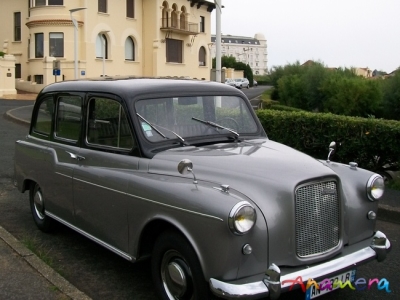
1962 Austin FL2, front view
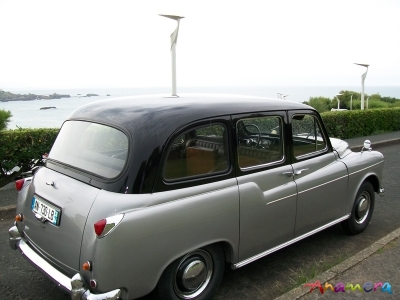
1962 Austin FL2, rear view
The Austin FL2 Hire Car was the limousine version of the FX4. Introduced at the same time as the FX4, it was aimed at the private hire, limousine and funeral trade and this market was the main reason why the petrol engine was offered in the vehicle. It had forward-facing occasional seats, a second front seat and carried no roof sign. It could also be ordered with special trim at extra cost. It was also the base of a small number of Hearses.
The FL2 was relaunched in 1982 as the FL2 London Limousine, based on the FX4R. Air conditioning was offered as well as a wider range of luxury interior options, including a cocktail cabinet and custom sound systems. Three stretch versions were built, with four doors and an 18-inch extension between the front and rear doors. A six-door version of the FX4S was also built. The FL2 designation was dropped around 1987, but limousine versions of the Fairway were ordered, the most prominent being that belonging to the Crown Prince of Tonga.
The FL2 and the FX4 were also sold to private customers. FL2 customers included Prince Philip, Duke of Edinburgh and Laurence Olivier. The actor Stephen Fry owned a Fairway as his own private transport. An FX4 London taxi was the official car of the Governor of the Falkland Islands, Rex, later Sir Rex Hunt at the time of the Argentinean invasion.
EVOLUTION OF THE AUSTIN/CARBODIES/LTI
Specification: Diesel engine, automatic transmission
| Model | Model year | Engine | Transmission Model | Door Handles | Wheels & brakes | Rear Window |
|---|---|---|---|---|---|---|
| FX4 | 1958-1968 | Austin 2.2L | BorgWarner DG150 3 Spd RWD | chrome lever handle | flat wheels drum brakes | tinted |
| FX4 | 1969-1971 | Austin 2.2L | BorgWarner DG150 3 Spd RWD | chrome lever handle | flat wheels drum brakes | clear |
| FX4D | 1971-1978 | B.M.C. 2.52L | BorgWarner BW35 3 Spd RWD | chrome push button | flat wheels drum brakes | clear |
| FX4D | 1978-1982 | B.M.C. 2.52L | BorgWarner BW65 3 Spd RWD | chrome push button | flat wheels drum brakes | clear |
| FX4R | 1982-1985 | Land Rover 2.25L | BorgWarner BW65 3 Spd RWD | chrome push button | flat wheels drum brakes | clear |
| FX4-Q | 1984-1985 | Land Rover 2.52L | BorgWarner BW65 3 Spd RWD | chrome push button | flat wheels drum brakes | clear |
| FX4S | 1985-1987 | Land Rover 2.5L | BorgWarner BW40 4 Spd RWD | chrome push button | flat wheels drum brakes | clear |
| FX4S+ | 1987-1988 | Land Rover 2.5L | BorgWarner BW40 4 Spd RWD | chrome push button | flat wheels drum brakes | clear |
| Fairway | 1989-1992 | Nissan 2.7L | Nissan/Jatco E4N71B 4 Spd RWD | plastic black push button | flat wheels drum brakes | clear |
| Fairway Driver | 1992-1996 | Nissan 2.7L | Nissan/Jatco E4N71B 4 Spd RWD | plastic black push button | domed wheels front disc brakes | clear |
| Fairway Driver | 1997 (P, R reg) | Nissan 2.7L | Nissan/Jatco RL4R01A 4 Spd RWD | plastic black push button | domed wheels front disc brakes | clear |
| TX1 | 1997-2002 | Nissan 2.7L | Nissan/Jatco RL4R01A 4 Spd RWD | domed wheels front disc brakes | clear | |
| TX2 | 2002-2006 | Ford Duratorq 2.4L | Nissan/Jatco RL4R01A 4 Spd RWD | domed wheels front disc brakes | clear | |
| TX4 | 2007-2017 | VM Motori 2.5L | Chrysler 545RFE 5 Spd RWD | domed wheels front disc brakes | clear |
Metrocab
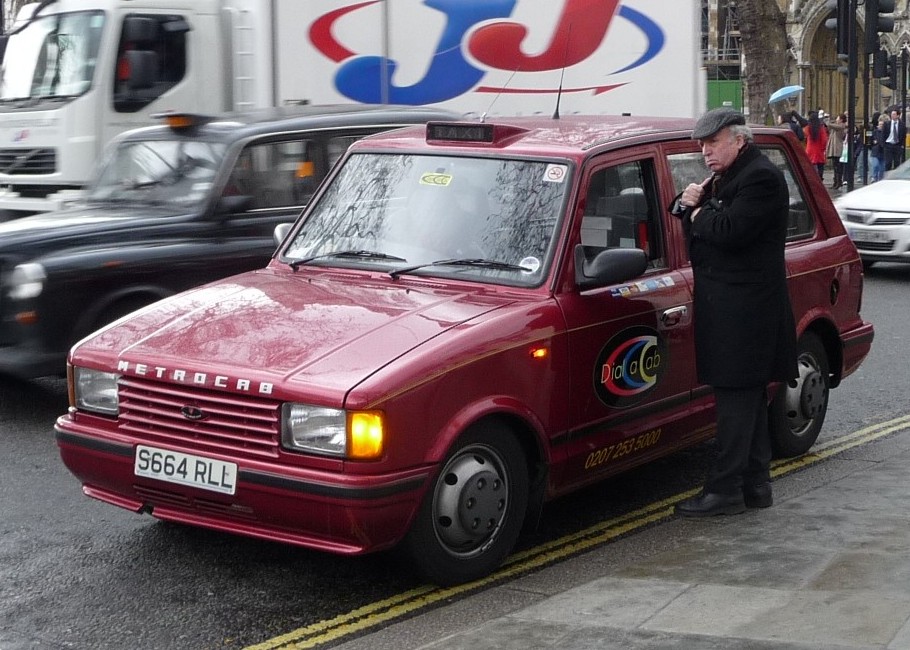
Metrocab
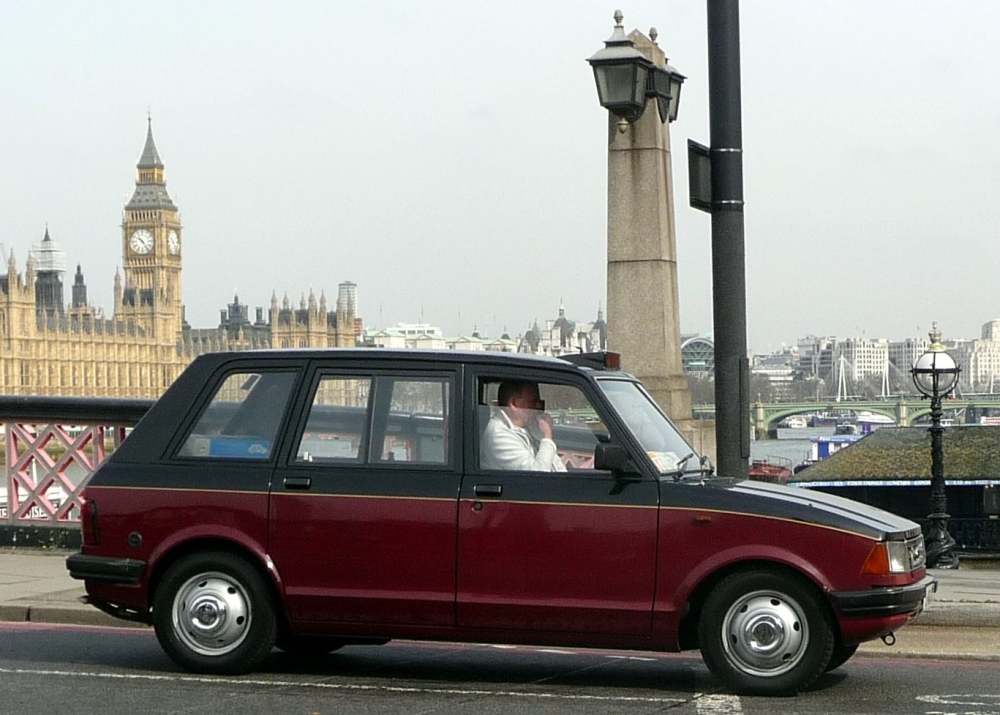
Metrocab
Metrocab Taxi Origins
The Metrocab taxi family tree can be traced back to strong links with the early makers of motorized hackney cabs. A large Scottish engineering group, William Beardmore & Company, was the first to introduce a new type of taxi cab following the end of the First World War. Introduced in 1919, the Beardmore cab claimed half of the London taxi market by the mid 1920s.
In later years, Beardmore taxis were less successful but continued through various models till the 1960s. From 1958, Beardmore taxi bodies were made by coach and bus builder Weymann Motor Bodies, at its factory in Addlestone, Surrey. Since 1932, Weymann had been part of a joint venture with Birmingham-based rail and bus builder Metropolitan Cammell, itself a division of the engineering and shipbuilding giant, Cammell Laird.
In 1963/4 Metro-Cammell itself bought out Weymann. MCW bus and taxi production (for Beardmore) continued at Addlestone. However a 21 week long strike in 1964 brought the Weymann factory to its knees. In 1965 the closure of the Addlestone factory was announced. The factory duly closed the following year, with all MCW production moving to the Metro-Cammell factory at Elmdon, in Solihull, near Birmingham. From 1966 on, the Metropolitan Cammell Weymann name was dropped and only the abbreviated MCW title used.
Beardmore taxi production stopped in 1967, the Beardmore company itself going to the wall shortly thereafter. However the link with taxi production was to survive through key staff working at MCW. They had begun design and development work for a new taxi cab - originally named the Metro-Beardmore - but with the demise of Beardmore, MCW took on the project, which duly became the MCW Metrocab taxi by the time of its launch.
The First Metrocab Taxi
With the cab trade increasingly disgruntled over LTI's virtual monopoly in London and its failure to come up with a new model to replace the ageing FX4, there was considerable interest in the potential for a choice of taxi at long last. For many, the MCW Metrocab taxi appeared to fit the bill.
Sporting a modern-looking shape, the first Metrocab taxi offered a Perkins diesel engine. In a major innovation the new taxi cab had an all-fibre-glass body. This made the Metrocab both light and therefore economical to run and also rust-proof - answering a key sore point on the dominant Carbodies FX4 taxi cab.
Initially the Metrocab taxi was adopted by the large London General fleet. However after working it for a couple of years this key taxi operator declined to invest in further development of the cab. Metrocab production ceased and the whole taxi project was shelved.
Reborn Metrocab Taxi
That seemed to be as if the short-lived Metrocab brand had disappeared from the taxi sales world. Yet owners MCW apparently had long memories - or at least could still see the potential of attempting to break LTI's unnatural taxi sales monopoly in London.
During the early 1980s Geoff Chater, a taxi engineer from Carbodies (later LTI), joined MCW and worked to recreate the Metrocab taxi concept, along with ex Peugeot-Talbot man Bob Parsons. 17 years on from the first Metrocab taxi - and after almost two decades of LTI virtual taxi monopoly in London - the Metrocab was re-launched, in May 1987.
Looking not unlike its ill-fated predecessor, the new MCW Metrocab taxi was also fibre-glass-bodied, with a modern 2.5L Ford Transit engine. This Metrocab taxi was also less leaky and more economical than the competition. Metrocab was also the first wheelchair accessible taxi, in anticipation of coming legislation and the first taxi licensed in London to carry four passengers.
The new Metrocab taxi design leaned on a variety of parts from other production vehicles, including a Ford grille. The downside of the new Metrocab taxi, however, proved to be the gearbox. A late change of supplier forced Metrocab to use a Ford automatic gearbox with little testing, shortly before production started.
MCW's second Metrocab project gained some effective dealers, such as Ashfield Motors, which held the Scottish franchise and later coordinated Metrocab taxi sales nationally. The taxi market was clearly keen for a choice of cabs and sales began to build, despite some initial reliability issues.
In 1989, however, MCW's parent company, now named the Laird Group, ran into difficulties connected with the massive Channel Tunnel project, which forced it to divest its train, bus and taxi-making interests. These were sold off separately, with the Metrocab taxi name and design being acquired by another West Midland's firm, Reliant. Best known for their three-wheeler cars for disabled people, Reliant also made the fibre-glass bodies for the MCW Metrocab taxi and now moved full Metrocab production to its factory at Tamworth.

1990 Reliant Metrocab
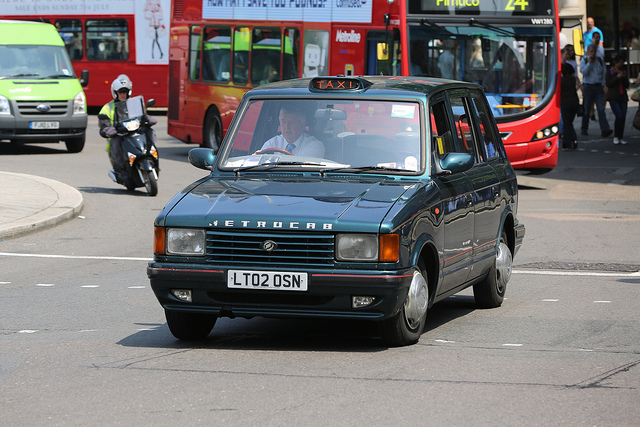
Metrocab TTT
Metrocab Taxi in the 1990s
Other commercial troubles forced Reliant to sell off the Metrocab taxi business, in 1991, to Hooper, a London coach-builder, now turned sales and service agent. Metrocab taxi production continued in Tamworth and Hooper breathed new impetus into development of the Metrocab taxi, with important improvements such as the first disc brakes featured on a purpose-built UK hackney cab. 1995 saw the launch of the Series II Metrocab taxi, with several cosmetic design enhancements and 1997 brought the Series III Metrocab taxi, which even provided electric windows for the cab driver. Six and even seven seat versions provided further revolution for the cab trade and helped attract growing taxi sales volumes.
Metrocab was also now achieving a 25% share of taxi sales in London, to the horror of the previously unchallenged Carbodies - Mann and Overton empire (now reincarnated as London Taxis International (LTI)).
Metrocab TTT Taxi
For many Metrocab fans the 'triple T' model, launched in 2000, represents the finest Metrocab taxi. In part it was born out of necessity, as new Euro 3 emissions regulations forced a change from the original Ford Transit engine. Metrocab turned to Japan and fitted the TTT taxi with a 2.4L turbo-diesel from Toyota.
With the support of key dealers, which now included Allied Vehicles in the north, Metrocab taxi sales continued at significant levels. However, the investment pressure to develop the next generation of Metrocab taxi, together with the London taxi market dominance of LTI and strong new provincial competition from modern-style taxis like the Peugeot Euro 7, caused Metrocab to struggle to reach minimum taxi sales volumes to keep the business viable.
Metrocab Taxi Death Throws
Metrocab went into administration and ceased taxi sales and production in 2003, loosing almost 100 jobs at the Tamworth plant. New owners, Singapore-based KamKorp, reinstated production for a short time in 2005, before the factory gates shut for the last time.
With regular care and replacement parts Metrocabs remained in service for many years. However they are now increasingly rare, with very few now remaining in operation and Metrocab taxi parts supply becoming ever-more difficult.
LTI TX1 (1997-2002)

TX1 front view
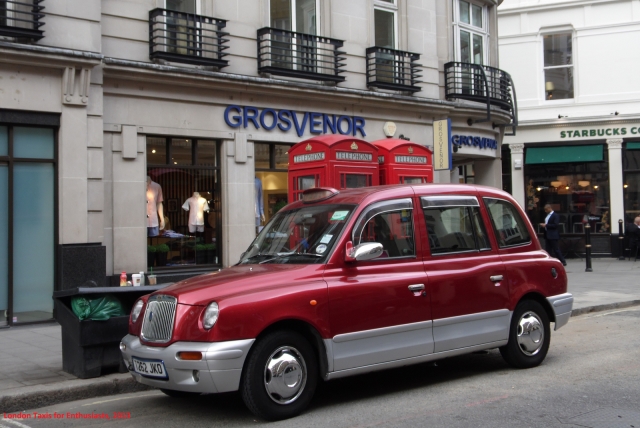
TX1 side view
The TX1 was introduced by London Taxis International in 1997 and designed to replace the aging FX4. Most are powered by the same Nissan diesel TD27 engine as the Fairway Driver.
The body was designed to recall several distinctive styling cues of the FX4, although rear suicide doors were abandonned. Upon completion, it won cab drivers' approval as sufficiently maintaining the spirit of the London cab.
LTI TX2 (2002-2006)
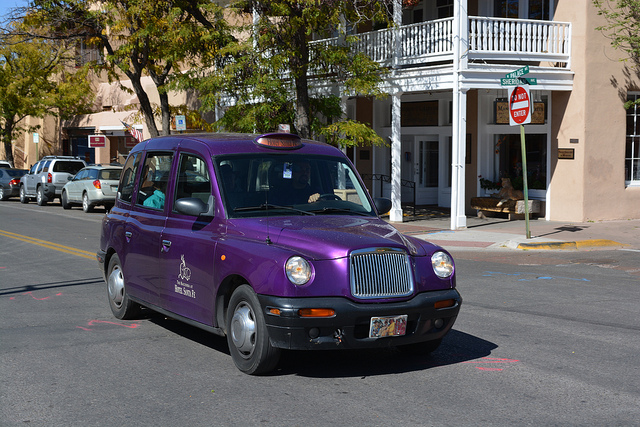
TX2 front view

TX2 side view
The TXII or TX2 was manufactured by LTI in 2002. It is the second model following the modernisation and re-design of the London taxi that began with the TX1.
The vehicle has a handful of differences from its predecessor including a change of engine from Nissan to the intercooled Ford Duratorq, as found in the Ford Transit, Mondeo, and Land Rover Defender.
The remaining modifications are minor improvements to the design and equipment on the TX1. It was available with a five-speed manual or a four-speed automatic.
It was succeeded in 2006 by the TX4.
LTC TX4 (2007-to this day)
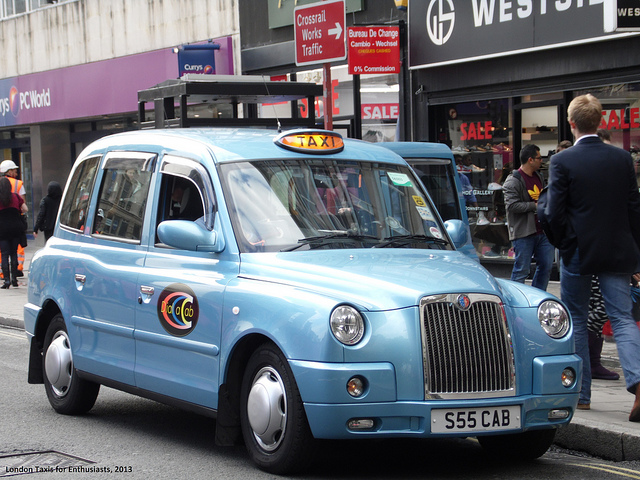
TX4 front view
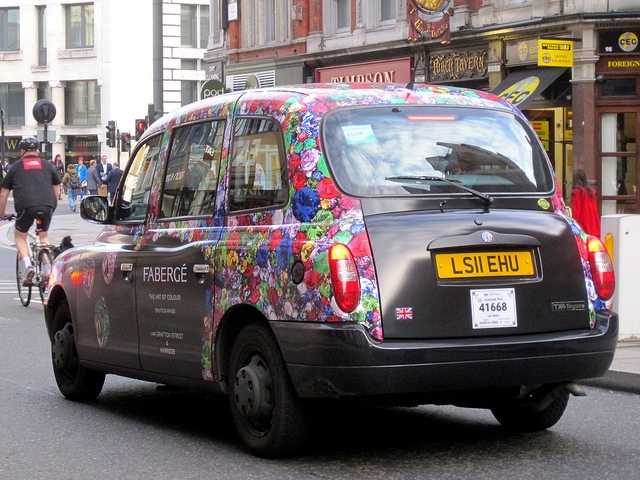
TX4 back view
The TX4 is a purpose-built taxicab (hackney carriage) manufactured by The London Taxi Company (formerly LTI Vehicles), a subsidiary of Manganese Bronze which has itself been wholly owned since 2013 by Geely Automobile of China.
The TX4 is the latest in a long line of purpose-built taxis produced by The London Taxi Company. The TX4 takes virtually all of its body styling from its predecessor, the TXII.
The TX4 features a new front radiator grille, an updated interior design, updated front and rear bumpers, and a different rear vehicle registration number plate surround compared to the TXII. There are now internal headrests as a result of EU safety regulations. On the earlier models there were two headrests fitted to the central partition for the rear-facing tip-up seats, but on the later models these were removed as drivers complained and found them awkward for vision reasons.
The only engine offered in the UK is a 2.5 VM Motori R 425 DOHC diesel engine (rated at a peak 75 kW or 101 hp at 4,000 rpm and 240 Nm of torque at 1,800 rpm) mated to a Chrysler 545RFE five-speed automatic transmission. An Eaton FSO 2405 A five-speed manual transmission is also available.
In markets outside the UK the TX4 is also available with a 2.4 Mitsubishi 4G69 four-cylinder petrol engine, rated at 112 kW (152 PS) at 5,500 rpm and 212 Nm at 4,000 rpm. The only gearbox available with this engine is a Mitsubishi-built five-speed manual.
As was the case with its predecessors the TX4 is built on a fully boxed hydroformed ladder frame with a separate body.
The front suspension, as with its predecessors, is of the double wishbone type with coil springs and an anti-roll bar while the rear suspension uses a solid axle with coil springs and a Panhard rod.
The reason for its being named TX4 instead of TX3 is because the engine was Euro IV compliant, and also for the vehicle to have a connection with the famous Austin FX4. The diesel engine is now Euro 5 compliant.
Chinese market
In January 2007, an Extraordinary General Meeting of the LTI's shareholders approved a joint venture with Geely Automobile-called Shanghai LTI(SLTI)-to manufacture the TX4 in China. Production started in July 2008. In August 2010 Geely disclosed that Shanghai LTI began supplying SKD (semi-knocked-down) TX4 to the UK. Geely sells the TX4 cab under their "Englon" brand, but have also developed a new version called the TXN. The TXN, planned to go on sale in the future, has a more bulbous shape meant to be more youthful. A concept version called the Englon SC7-RV has also been shown in 2011; this is intended to be used as a private family saloon.
TX4 Worldwide
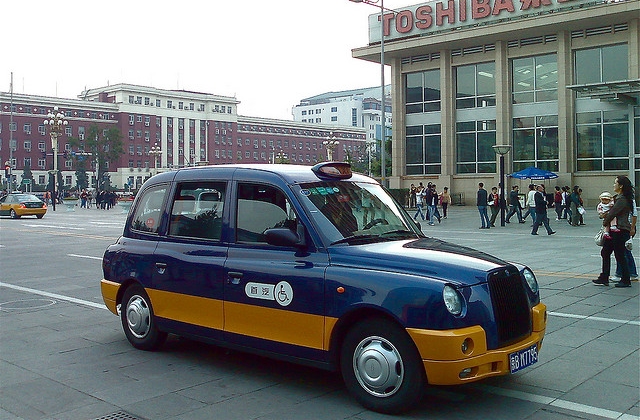
TX4 in China
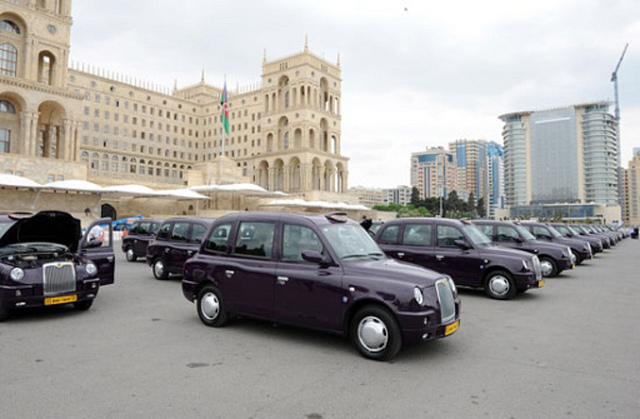
TX4 in Bakou, Azerbaidjan
The TX4 taxi can be seen in service in London, Baku, Cairo, Pristina, Berlin, Ottawa, Charleston, South Carolina, with "Desert Cabs" of Las Vegas, Sunshine Taxi in Hudson, Massachusetts, Singapore, Johannesburg and Nanjing.
Recalls, Engine failures, Faults and Problems
Fire issues
In September 2008, approximately 15 engine fires in a period of three months forced a partial recall of the TX4. A limited number of vehicles were affected and the Public Carriage Office-now renamed LTPH (London Taxis and Private Hire)-required all models with a '56' registration plate to undergo safety checks otherwise drivers would lose their carriage licence.
Steering Boxes
Manganese Bronze, the by now troubled maker of the famous London taxis, was thrown into further turmoil after it announced plans to recall 400 black cabs and suspend sales, following discovery of a steering fault. Manganese reported the discovery of a defect with new steering boxes in its TX4 models, which had been introduced in February 2012 to vehicles produced at its Coventry factory. It warned that the recall and sales suspension would have a "material and detrimental" impact on its cashflow and said it was looking at options for the firm. The news came as the latest blow to the company, which had been hit by mounting losses and an accounting blunder that left it with a £4 million hole in its accounts. Manganese, which suspended trading of its shares earlier in the day, said it was working with Chinese partner Geely (already a 20% shareholder in the business) to fix the steering fault. But they said: "Until such time that a technical solution is developed to rectify the fault, the financial position of the group remains unclear and trading in the company's shares will remain suspended." The company had not reported any profits since 2008.
Administration and a new owner for the business
On 30 October 2012 Manganese Bronze Holdings went into administration, and on the 31 October 2012 PricewaterhouseCoopers, the administrators, shed 156 jobs at the Coventry head office and production line, and other jobs at various dealer outlets around the country including London. Production at the Coventry site resumed in September 2013, ownership of the assets formerly owned by Manganese bronze having now passed to Geely of China.